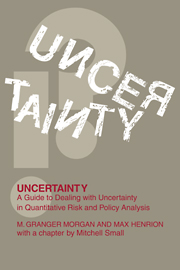Book contents
- Frontmatter
- Contents
- Preface
- 1 Introduction
- 2 Recent Milestones
- 3 An Overview of Quantitative Policy Analysis
- 4 The Nature and Sources of Uncertainty
- 5 Probability Distributions and Statistical Estimation
- 6 Human Judgment about and with Uncertainty
- 7 Performing Probability Assessment
- 8 The Propagation and Analysis of Uncertainty
- 9 The Graphic Communication of Uncertainty
- 10 Analytical A Software Tool for Uncertainty Analysis and Model Communication
- 11 Large and Complex Models
- 12 The Value of Knowing How Little You Know
- Index
5 - Probability Distributions and Statistical Estimation
Published online by Cambridge University Press: 05 June 2012
- Frontmatter
- Contents
- Preface
- 1 Introduction
- 2 Recent Milestones
- 3 An Overview of Quantitative Policy Analysis
- 4 The Nature and Sources of Uncertainty
- 5 Probability Distributions and Statistical Estimation
- 6 Human Judgment about and with Uncertainty
- 7 Performing Probability Assessment
- 8 The Propagation and Analysis of Uncertainty
- 9 The Graphic Communication of Uncertainty
- 10 Analytical A Software Tool for Uncertainty Analysis and Model Communication
- 11 Large and Complex Models
- 12 The Value of Knowing How Little You Know
- Index
Summary
The theory of probability is at the bottom nothing but common sense reduced to calculus.
Pierre de Laplace, Théorie Analytique de Probabilités, introduction, 1812–20Introduction
Suppose you wish to represent uncertainty about an empirical quantity by a probability distribution. If you have some empirical data directly relevant to the quantity, you may want to use statistical methods to help select a distribution and estimate its parameters. If you feel you know little or nothing about the quantity before seeing the observations, you may want to use standard classical statistical methods. If you feel you do have some prior opinions about the quantity, based on whatever knowledge and reasoning, you may want to combine these prior opinions with the observed evidence and use Rayesian updating methods to obtain posterior distributions. If you have no directly relevant observations of the quantity, then you may wish to express your opinion directly by a subjective probability distribution. We discuss methods for doing this Chapters 6 and 7, but before getting to them it will be useful to review some of the basic properties of probability distributions.
The methods presented in this chapter cover a range of useful procedures in probability and statistics. The discussion is provided as a review and a compact reference and is not intended to replace a full course or text on the subject, many of which are available (e.g., Benjamin and Cornell, 1970; Ang and Tang, 1975; DeGroot, 1975).
Information
- Type
- Chapter
- Information
- UncertaintyA Guide to Dealing with Uncertainty in Quantitative Risk and Policy Analysis, pp. 73 - 101Publisher: Cambridge University PressPrint publication year: 1990
Accessibility standard: Unknown
Why this information is here
This section outlines the accessibility features of this content - including support for screen readers, full keyboard navigation and high-contrast display options. This may not be relevant for you.Accessibility Information
- 1
- Cited by
